The future of the past working place
In his essay from the Guardian Jonathan Franzen complains about todays overload of information caused by technology and the hype it causes. He criticizes all kinds of distractions by mobile phones, e-mail, Facebook, Twitter, etc. Even the hardware itself is part of the problem for him. The well designed laptop, like a Mac Air, is a priori a bad thing, no matter what you do with it, since its “shines” will blend you and make you drift away from your actual tasks. He uses a contemporary version of Karl Kraus’s dichotomy for comparison: “…when you’re working on some clunky, utilitarian PC, the only thing to enjoy is the quality of your work itself.” (Karl Kraus was an Austrian satirist and famous for his media and social criticism from the last century).

I look at the photograph of Jonathan Franzen above, and I simply love it. I love it for its simplicity of the work setting, a captain’s chair, a table, a lamp and an old Dell laptop – probably an Inspirion 8100. In the background, on the left-hand side, we can see a shovel signalizing that he must be sitting in a cottage on the countryside, with possibly, heavy snow outside. It is an assumption, since we don’t see any windows. There is a small ceramic object on the wall in front of him showing another chair. Everything else is removed, reduced, optimized, but not in a design way of a contemporary spatial “cleanness”, but in a very pure natural way. His desktop is almost empty and his Dell includes probably only the old version of Microsoft Word. No e-mail, no social apps, no graphic programs, DVD players, maybe not even an Internet browser. A very tempting working condition which indicates that the author is able to achieve a maximum of focus on his current work.
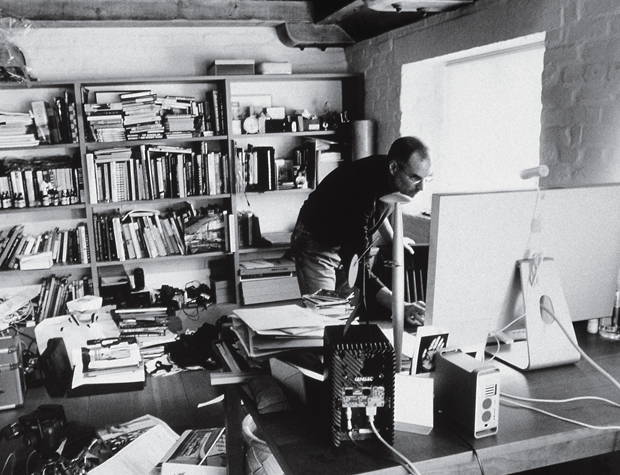
There are many photographs of famous people and their working environment. This is interesting to me, since the working condition reflects not only the character of the person, but also influences and even changes the character of the person. In other words, the space can define and can be defined through the way we work, what we work on and, finally, who we are. The photograph of Steve Jobs shows exactly the opposite of Franzen, although it is very coherent in its own right, since Jobs is the cause of all pretty distractions Franzen criticizes. By inventing things which he promises will helps us and make our lives easier, he is also creating a desire to do things of which we never thought of doing before, and so he is basically keeping us busy all the time. Moreover, we are very happy about it and enjoy it, no matter if we are working on our holiday photographs, cutting a celebration video or sorting and maintaining our iTunes library.
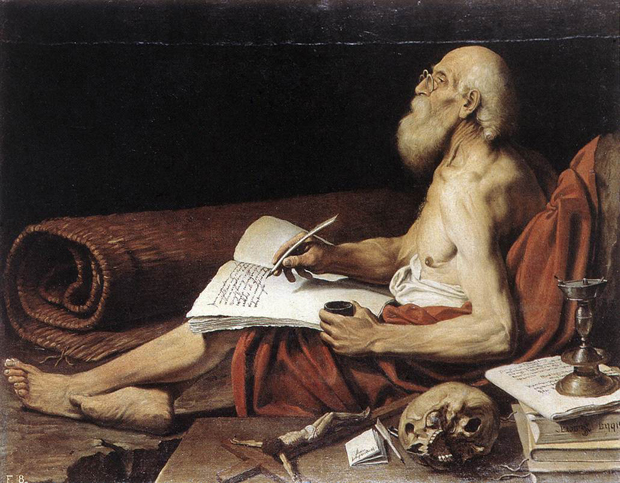
I am using these two examples here to show two quite opposite positions in the contemporary discussion about how the future workplace should be seen. One position is that we are disrupted by all kinds of technologies, media, software and gadgets, and therefore we need to get rid of all of these things in order to be able to focus on the actual work again. And the other position is that we should embrace the enhancing and beautifying opportunities which technology can offer us, although by doing so we are constantly adding new tasks to our never ending to-do list. Nevertheless, before we talk about the working condition of the present, or even envision the working place of the future, we need to look at the working place of the past. As a reference I am using a painting of St. Jerome by Lionello Spada. Jerome was a Latin Christian scholar and a doctor of the Church. He had a very turbulent youth, including lots of parties with dancing girls in Rome. Later he has decided to follow a life of ascetic penance, so he went to the desert where he found time for study and writing. Spada, a student of the famous Caravaggio, painted him during his work – probably translating the Bible from the original in Hebrew.
Although Jerome was not fluent in Hebrew, there are not many references, dictionaries, scripts etc. around him in Spada’s painting. Jerome, pictured in his priest’s cell, is focused, his eyes staring and looking forward. Did he just make things up or managed to translate thousands of pages without any referential documents, we don’t know, but he was obviously working in an environment where he could focus and concentrate, as Franzen is advocating.

However, we need to ask a question: Does the same intellectual work works in different settings or is it one working setting what we need for all kinds of mindful works? Moreover, does the same work process manifest itself differently in a different time period and lifestyle? St. Jerome’s focused writing has been painted differently in the Renaissance then in the Baroque. For example Albrecht Dürer, Palma il Vecchio, Domenico Ghirlandaio, Henry Steinwick, Jan van Eyck and Antonello da Messina (image above) painted the same religious scene with St. Jerome in completely different manners, conceptually and symbolically considering the working environment, ranging from Franzen-ish to Jobs-ish interior design.
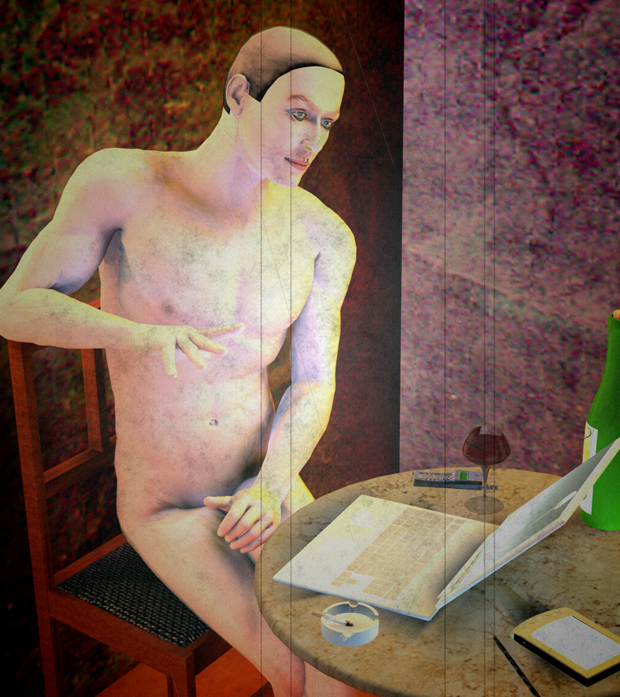
When we have envisioned ORTLOS years ago, one of the premises was that the new architecture will be reflected in the change of architectural practice. This means that if the architectural practice stays the same, then the architectural production will stay the same. Maybe its formal manifestation will get a different formal expression, more like a style, but its significant core will be frozen. The way how and where we do the things is directly manifested and expressed through the things we do.
Taking in account the mobile devices, embedded technology and pervasive computing, do we still have to work in studios or offices? Can we just bring our work outside and still be focused, let’s say at a nice Cafe in Sienna or in Berlin? Based on the painting by Otto Dix of German journalist Sylvia von Harden, I have made the above rendering as a conceptual reference to hail a new working environment of an urban nomad. Dix’s created an ambivalent image of the “New Woman”, which depicts von Harden with bobbed hair and monocle, seated at a Cafe table with a cigarette in her hand and a cocktail in front of her. I created an image of a “New Human”, a cyber dandy of an androgenic nature, naked and pure (almost like St. Jerome), seated at a Cafe table in front of a laptop, a mobile phone and a palm pilot (it was 1998).
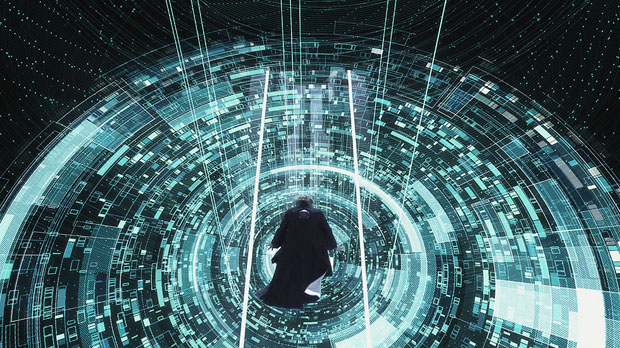
Talking about future working environments, everyone immediately asks the question how it will look like. Will it look like in Blade Runner, or Matrix, or Tron, or maybe like in Minority Report (many interfaces have used Tom Cruise’s gestures metaphor later on). The image above, from the movie “Tron Legacy”, shows Jef Bridges aka Kevin Flynn, software engineer and virtual reality expert, standing in the middle of the data stream he is manipulating and working with. His working place is deliberated from anything physical, his creation is based on information only. In his world “The Grid”, created through the isomorphic algorithms where humans and software agents live in symbiosis, everything looks real but nothing is haptic. It represents a typical sci-fi technotopia with a lot of charm and aesthetic value. And it can be seen as a conceptual contribution, because such a vision immediately rises the pro/contra debate where the extensive use of technology will lead us to in a few years.
But why not to ask the question what we want the future to do for us, instead of what it will be like; rather what we want to have and not what we need to adapt to. “If the media is an answer, the question must be very stupid”, is one of my favorite quotations. It basically means not to blame technology for what we are or for what we are about to become. But it also means not to draw concepts by explaining technology or listing its features. With other words, it is not technology’s fault that we are distracted from meaningful work because of all the things one can do with it. And the future of the working place is not to be found in equipping it with even more technology, adding up tech features on top of existing spaces and enhancing the current working condition – it is not about the evolutionary process.

What about the context in which a creative person operates? For example, nowadays, in architecture the architectural design is no longer the expression of a single individual as was still the case in Romanticism and classical Modernity. However, it is neither the expression of a collective as in the middle of the 20th century. It is rather the expression of a platform, a network of influences, continuously being reorganized by all participants. Discursive forums and artistic practices that do not aim for any durability take the place of the individual work of a single designer or group of designers. However, this is not contradictory to the premise that an architectural designer can not operate in a nomadic dislocated working setting. The idea here is that the designer can still be and work everywhere and nowhere in particular, if properly equipped. Since, the complexity of tasks and the amount of information a designer is dealing with has rapidly increased, there are some additional requirements to the working environment, which are beyond inhabiting a reduced empty space aimed for focused work.
The intelligent virtual development environment needs to provide the possibility for simulation, collaboration and interaction at once. A worldwide network of trans-disciplinary partners can interact with the virtual prototypes and collaborate using spatial interfaces. The methods and strategies for this operation are an integral part of architecture. The strategy is networked practice, the use of effective methods, tangible simulations and a common database.
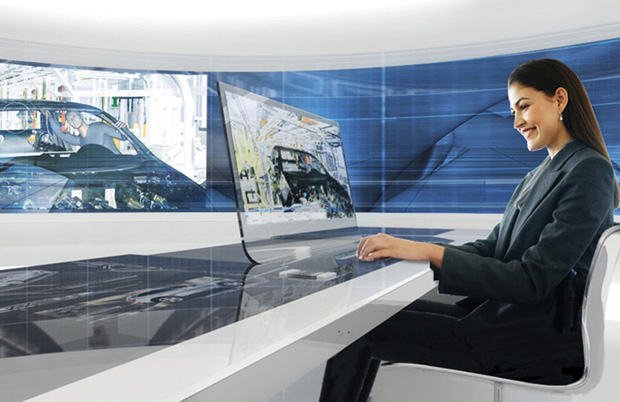
The engineer of the future is a knowledge worker. He works with data and information of various kinds. His product (the virtual prototype), his working setting (the virtual environment) and his collaboration environment (the virtual enterprise), altogether build “Lifecycle Intelligence” of innovative and creative product development. This new networked practice is based on: Engineering Intelligence, Ambient Intelligence and Connected Intelligence. At its center there is the knowledge engineer of the future. He uses various novel interfaces, e.g. for social interaction, knowledge visualization and communication in multi-agents systems. New design tools make him aware of diverse influences and information patterns that were not considered before.
The knowledge worker of the future needs a new intelligent ambience. And the crucial argument here is not considering the aesthetics or functions of this ambience, but its performance. Different interaction and simulation capabilities are combined and interconnected into a holistic concept of product development, supported by the usage of multi-modal interfaces and multi-functional responsive spaces.
Architecture coupled with the corresponding technology provides users with an infrastructure that enables access to data anywhere, is adaptable to various spatial settings and context-aware, i.e. a built-in intelligence which always adapts “on-demand” to the user. This performative aspect is invisible and implemented from the start in the spatial environment so that it allows a theoretically infinite flexibility and at the same time, it is open to new developments.

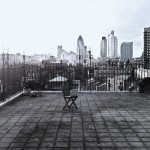
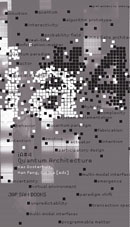
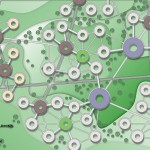







You must be logged in to post a comment.